Complete Solutions to Example of chapter CAPACITORS of Class 12 book with complete answers and questions
| Class 12 | PHYSICS |
| Chapter | CAPACITORS |
| SL ARORA | Example |
| Number Of Questions | 60 |
| Academic Year | 2023-24 |
The Capacitance of a conductor is 1 Farad. What do you mean by this statement ?
View SolutionIf the earth is assumed to be a sphere of radius `6.4xx10^(3)km`, then what will be its capacitance?
View SolutionIf dielectric strength of air (minimum field required for ionisation of a medium) is `3 M V//m`, can a metal sphere of radius 1cm hold a charge of 1 coulomb ?
View SolutionTwenty seven charged water droplets each with a diameter of 2 mm and a charge of `10^(-12)C` coalesce to form a single drop. Calculate the potential of the bigger drop.
View SolutionAn isolated sphere has a capacitance of 50 pF. (a) Calculate its radius. (b) how much charge should be placed on it to raise its potential ot `10^4 V`?
View SolutionA capacitor of `20muF` is charged to a potential of 10kV. Find th charge accumulated on each plate of the capacitor.
View SolutionWhen `1.0 xx 10^12`electrons are transferred from one conductor to another, a potential difference of `10 V` find the capacitance of the two -conductor system .
View SolutionWhat is the area of the plates of a 2 farad parallel plate air capacitor, given that the separation between the plates is 0.5 cm?
View SolutionCalculate the capacitance of a parallel plate capacitor having circular discs of radii `0.05m` each. The separation between the discs is `1 mm`.
View SolutionA parallel -plate capacitor having plate area `25.0`cm^ and a separation`2.00`mm between the plates .the capacitor is connected to a bettery of `12.0`V.(a)find the charge on the capacitor .(b) the plate separation is decrerased to `1.00`mm. Find the extra charge given by the bettery to the positive plate.
View SolutionA spherical capacitor has an inner sphere of radius 9 cm and an outer sphere of radius 10 cm. the outer sphere is earthed and the inner sphere is charged. What is the capacitance of the capacitor?
View SolutionThe thickness of air layer between two coating of a spherical capacitor is 2cm. The capacitor has same capacitance as the sphere of 1.2m diameter. Find the radii of its surfaces.
View SolutionAssuming an expression for the potential of an isolated conductor, show that the capacitance of such a sphere will be increased by a factor n, if it is enclosed within an earthed concentric sphere, the ration of the spheres being `n/(n - 1)`.
View SolutionA cylindrical capacitor has two co-axial cylinders of length 15 cm and radil 1.5 and 1.4 cm.The outer cylinder is earthed and inner cylinder is given a charge of `3.5 muC`. Determine the capacitance of the system and the potential of the inner cylinder. Neglect end effects (i.e., bending of field lines at the ends.)
View SolutionThree resistors of `2 Omega, 3 Omega and 4 Omega` are connected in
(a) series
(b) parallel.
Find the equivalent resistance in each case.
View SolutionTwo capacitors have a capacitance of `5 muF` when connected in parallel and `1.2 muF` when connected in series. Calculate their capacitance.
View SolutionThree capacitors of equal capacitance, when connected in series have net capacitance `C_(1)`, and when connected in parallel have net capacitance `C_(2)`. What is the value of `C_(1)//C_(2)`?
View SolutionWhat is the capacitance of arrangement of `4` plates each of area `A` at a distance `d` in air in Fig.

View SolutionWhat is the capacitance of arrangement of `4` plates each of area `A` at a distance `d` in air in Fig.

View SolutionHow will you connected four capacitors, each of capacitance `1muF` to obtain a net capacitance of `0.75muF`? Draw a diagram to show the combination
View SolutionConnect three capacitors of `3 muF, 3 muF` and `6 muF` such that their equivalent capacitance is `5 muF`.
View Solution
Calculate the capacitance of the capacitor in figure. If the equivalent capacitance of the combination between A and B is `15muF`.
View SolutionAn electric technician requires a capacitance of `2muF` in a circuit across a potential difference of 1kV. A large number of `1muF` capacitors are available to him each of which can withstand a potential difference of not more than 400V. Suggest a possible arrangement that requires the minimum number of capacitors.
View SolutionThree capacitors each of capacitance 9 pF are connected in series. (a) What is the total capacitance of the combination ? (b) What is the potential difference across each capacitor if the combination is connected to a 120V supply.
View SolutionThree capacitors of capacitance `2 pF, 3 pF and 4 pF` are connected in parallel. (a) what is the total capacitance of the combination ? (b) Determine the charge on each capacitor, If the combination is connected to 100V supply.
View SolutionA `80muF` capacitor is charged by a 50V battery. The capacitor is disconnected from the battery and then connected across another uncharged `320muF` capacitor. Calculate the charge on the second capacitor.
View SolutionIn fig. `C_(1) = 20 muF, C_(2) = 30 muF and C_(3) = 15 muF` and the insulated plate of `C_(1)` is at a potential of 90 V, one plate of `C_(3)` being earthed. What is the potential difference between th plates of `C_(2)` three capacitors being connected in series ?
View SolutionIn the figure a potential of `+ 1200 V` is given to point `A` and point `B` is earthed, what is the potential at the point `P` ?
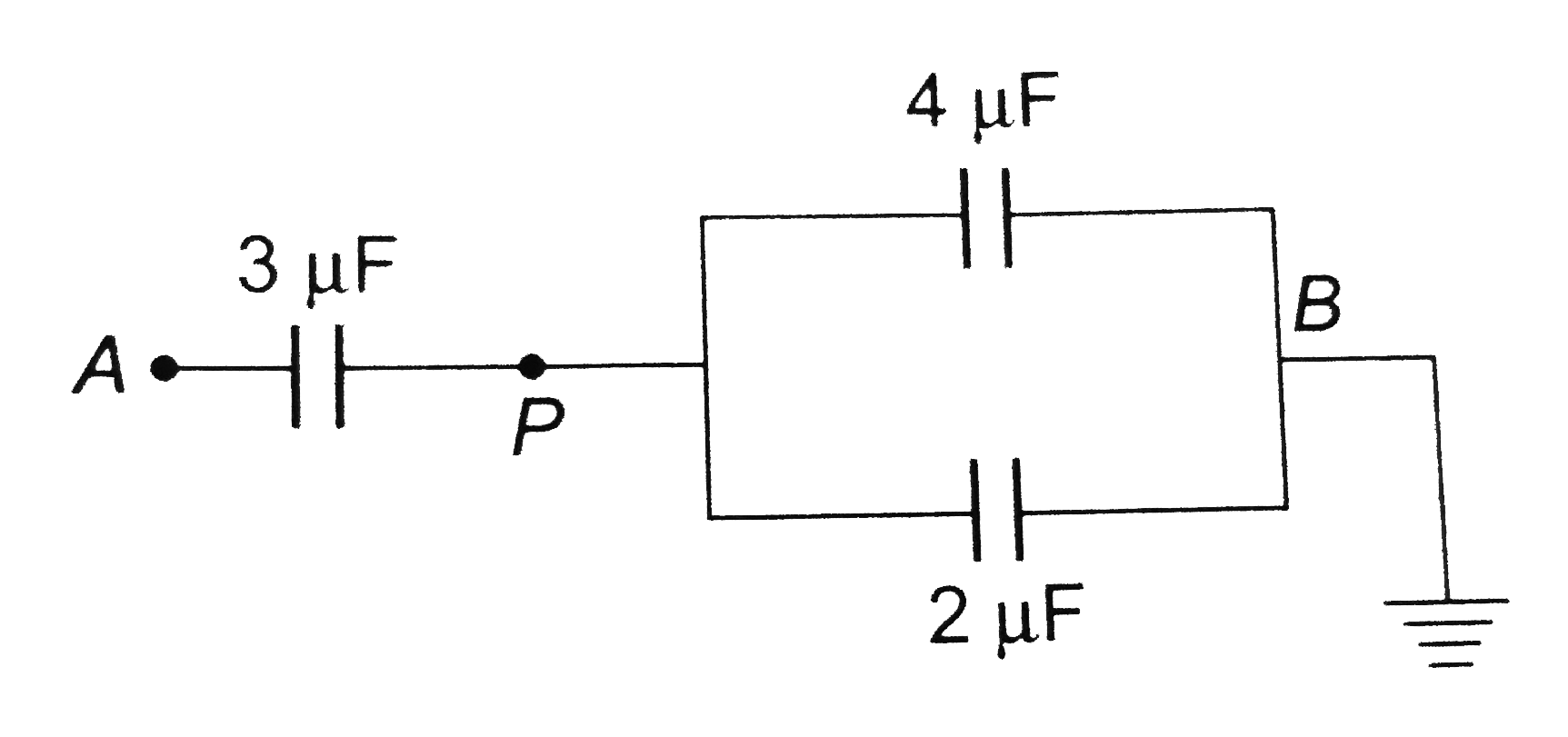
View SolutionObtain equivalent capacitance of the following network, Fig. For a 300V supply determine the charge and voltage across each capacitor.
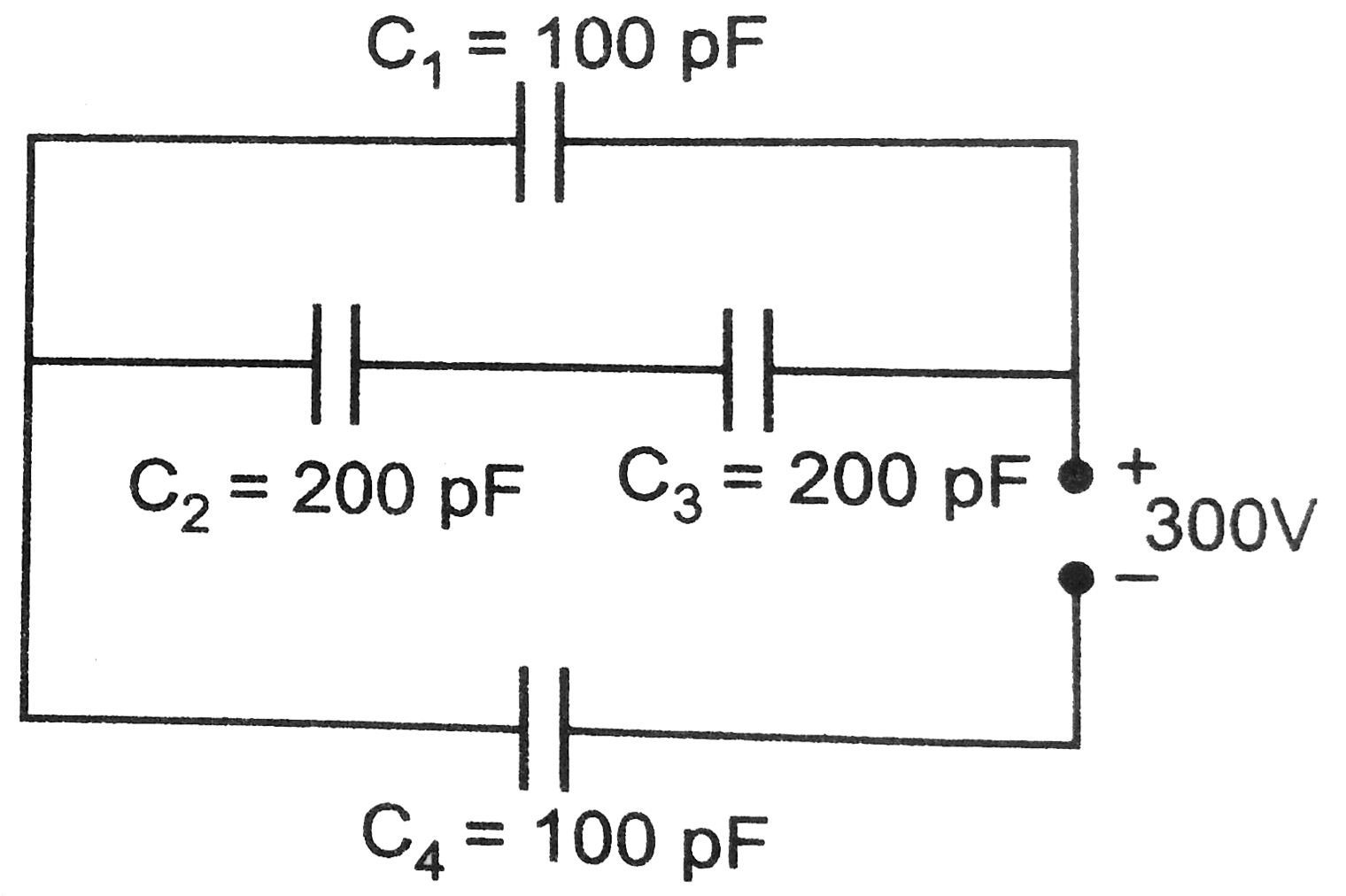
View SolutionA network of four `10 muF` capcitors is connected to a 500V supply as shown in Fig. Determine the (a) equivalent capacitance of the network and (b) charge on each capacitor.
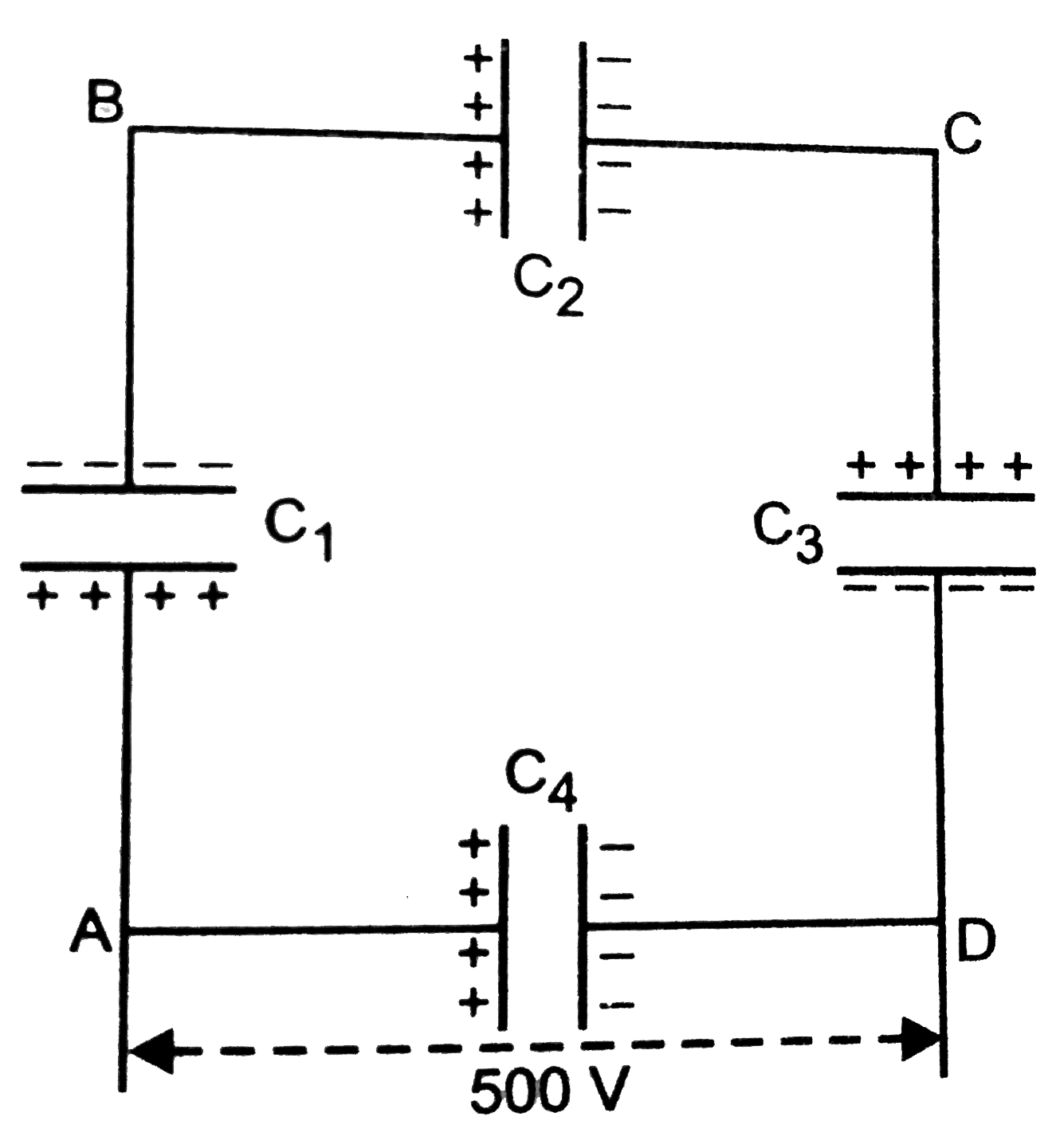
View Solution
Four capacitors are connected as shown in the figure. Calculate the equivalent capacitance between the point X and Y.
View Solution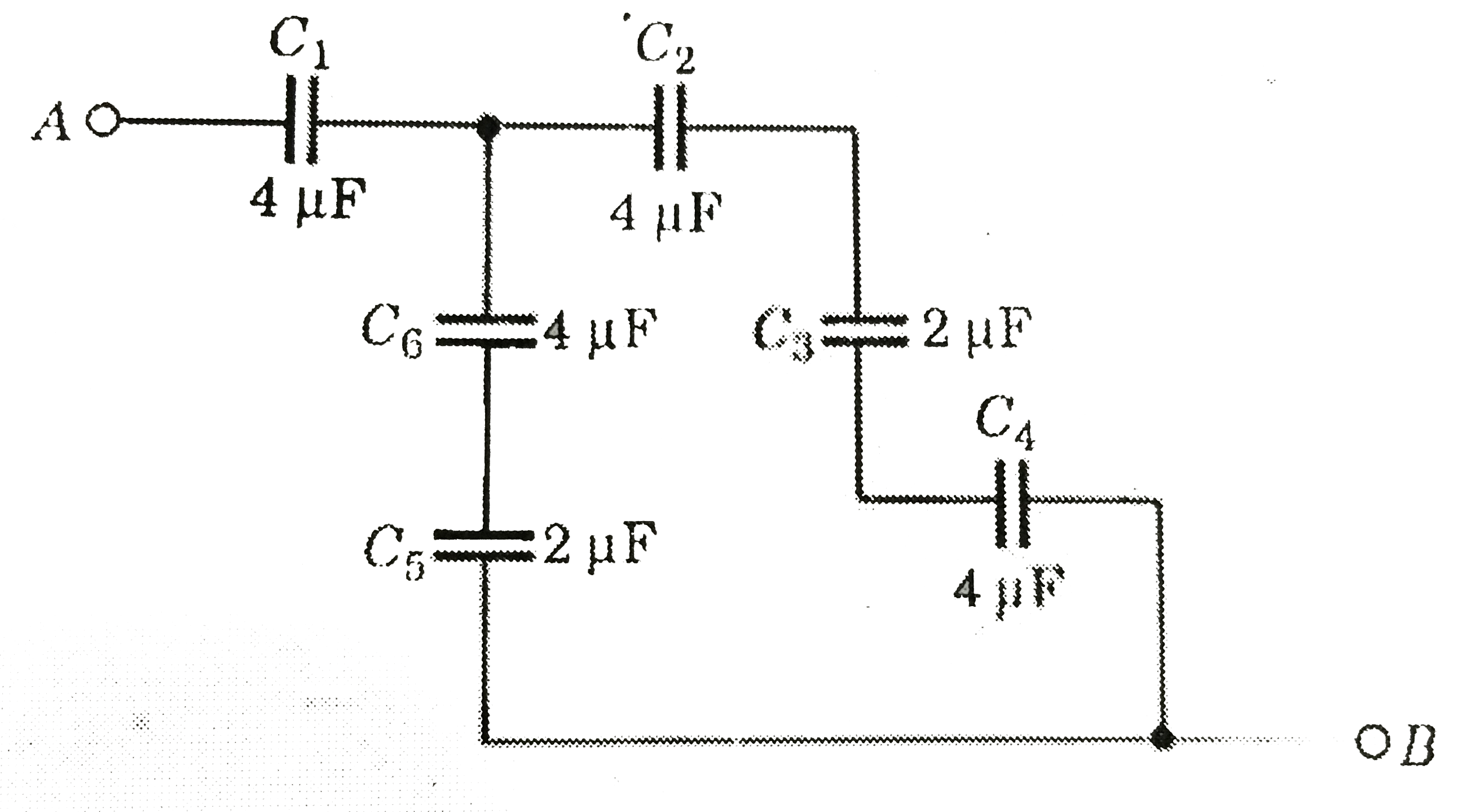
Calculate the equivalent capacitance between the points A and B of the circuit given below.
View SolutionIf `C_(1) = 3 pF` and `C_(2) = 2 pF`, calculate the equivalent capacitance of the network shown in Fig between points `A` and `B`.
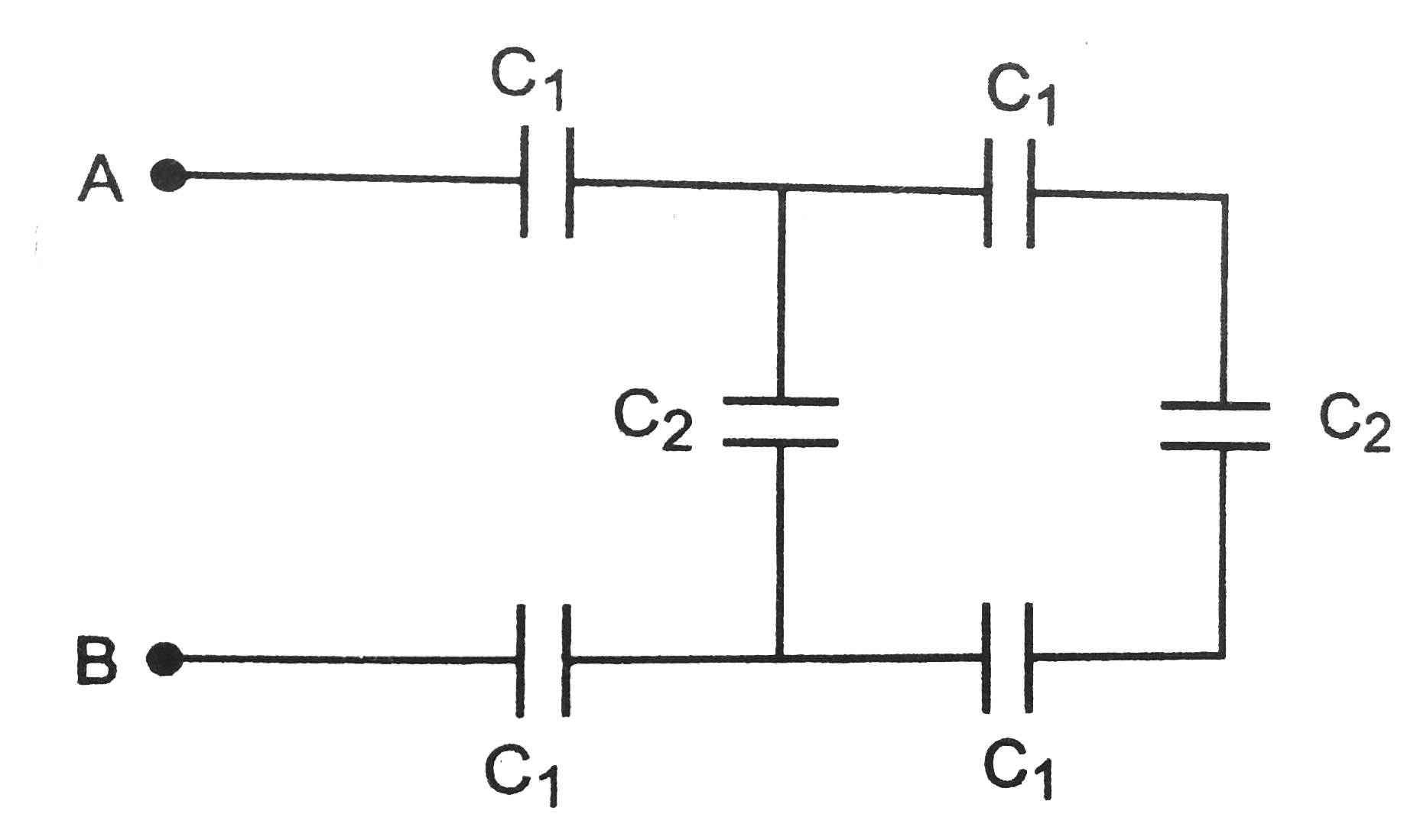
View Solution
Five capacitors of capacitance `10muF` each are connected with each other, as shown in figure. Calculate the total capacitance between the points A and C.
View SolutionFive identical capacitor paltes, each of area A, are arranged such that adjacent plates are at a distance d apart, the plates are connected to a source of emf V as shown in the figure
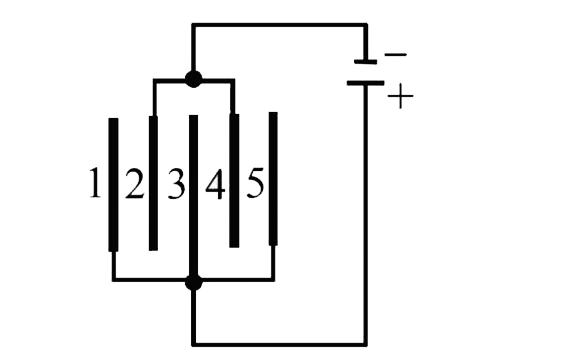
The charge on plate 1 is ………..and on plate 4 is.............
View SolutionFind the energy stored in a capacitor of capacitance `100muF ` when it is charged to a potential difference of 20 V.
View SolutionFor flash pictures, a photographer uses a capacitor of `30muF` and a charger that supplies `3xx10^(3)`V. find the charge and energy expended in joule for each flash.
View SolutionA `4muF` capacitor is connected to another `8muF` capacitor. The combination is charged at 300V. Calculate
(i) total charge on the combination
(ii). Total energy stored in the combination.
View SolutionTwo capacitors `C_(1)=3muF` and `C_(2)=6muF` in series, are connected in parallel to a third capacitor `C_(3)=4muF`. This arrangement is then connected to a battery of e.m.f., =`30V`, as shown. The energy lost by the battery in charging the capacitors
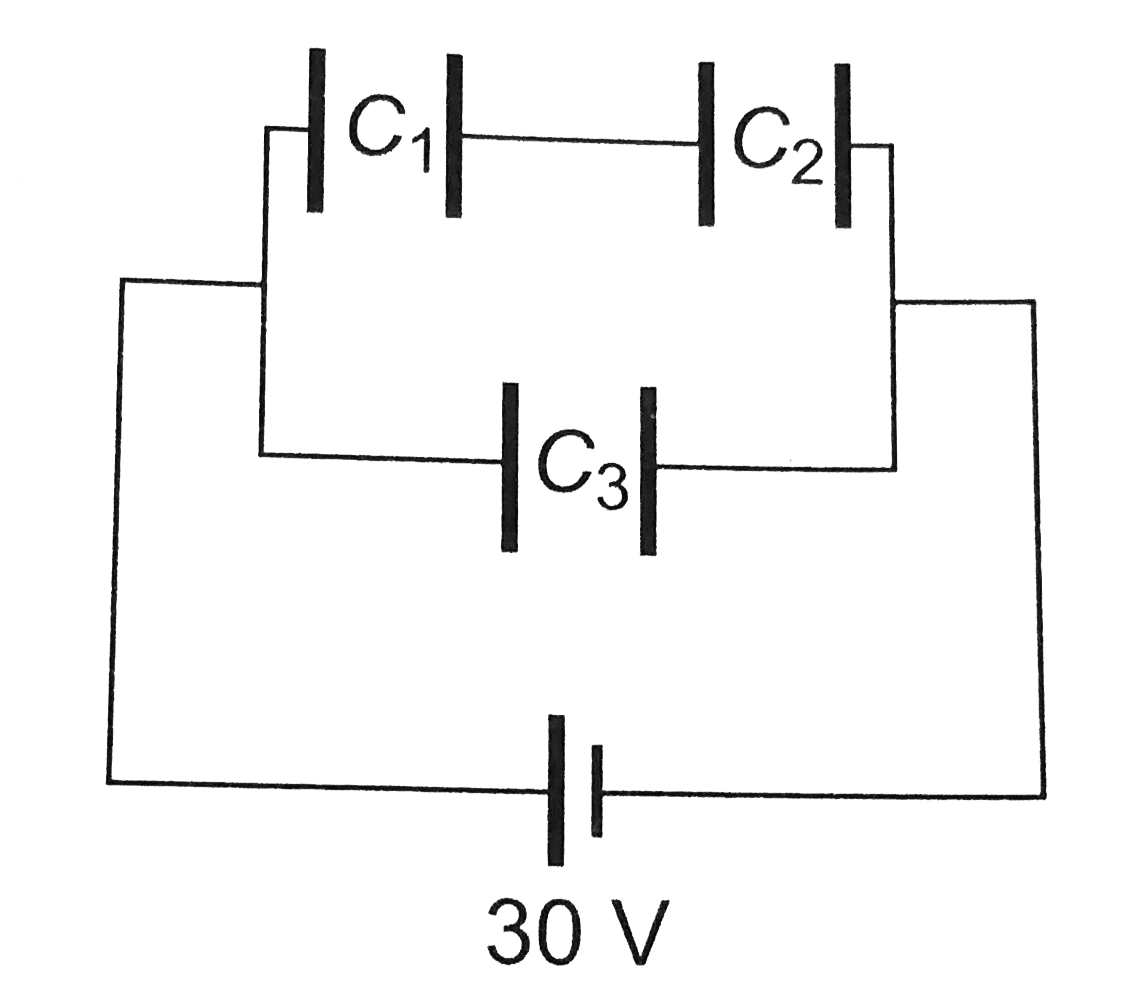
View SolutionThe plates of a paralllel plate capacitor have an area of `90 cm^(2)` each and are separated by 2.5mm. The capacitance is charged by connecting it to a 400V supply.
(a) How much electrostatic energy is stored by the capacitor ?
(b) View this energy as stored in the electrostatic field between the plates, and obtain the energy per unit volume (u). Hence arrive at a relation between U and the magnitude of electric field E between the plates.
View SolutionA `600 pF` capacitor is charged by a `200 V` supply. It is then disconnected from the supply and is connected to another uncharged `600 pF` capacitor. What is the common potential in `V` and energy lost in `J` afrte reconnection?
View SolutionAn uncharged capacitor is connected to a battery. Show that half the energy supplied by the battery is lost as heat while charging the capacitor.
View SolutionA capacitor of `20 muF` is charged to `500` volts and connected in parallel ith another capacitor of `10 muF` and charged to `200` volts. The common potential is
View SolutionA `4 muF` capacitor is charged by a 200 V supply. It is then disconnected from the supply and is connected to another uncharged `2 mu F` capacitor. How much electrostatic energy of the first capacitor is disspated in the form of heat and electromagnetic radiation ?
View SolutionA 900 pF capacitor is charged by 100V battery.
(a) How much electrostatic energy is strored by the capacitor ? The capacitor is disconnected from the battery and connected to another 900 pF capacitor. How much is the electrostatic energy stored in the system ?
View SolutionTwo capacitors are in parallel and the energy stored is 45J, when the combination is raised to potential of 3000 V. with the same two capacitors in series, the energy stored 4.05J for the same potential. What are their individual capacitances?
View SolutionWhen two charged conductors having different capacities and different potentials are joined together, show that there is always a loss of energy.
View SolutionA capacitor is charged to potential `V_(1)`. The power supply id disconnected and capacitor is connected in parallel to another uncharged capacitor. Calculate common potential of the combination of capacitors. Show that total energy of the combination is less than sum of energies stored in them before they are connected.
View SolutionA parallel plate capacitor with air between the plates has a capacitance of 8 pF.`(1 pF = 10^(-12)F)` What will be the capacitance if the distance between the plates is reduced by half and the space between them is filled with a substance of dielectric constant 6 ?
View SolutionFind the length of the paper used in a capacitor of capacitance `2muF`, if the dielectric constant of the paper is 2.5 and its width and thickness are 50 mm and 0.05mm, respectively.
View SolutionA parallel plate capacitor is to be designed with a voltage rating 1 KV using a material of dielectrical constant 3 and dielectric strength about `10^(7) Vm^(-1)`. [Dielectric strength is the maximum electric field a material can tolerate without break down, i.e, without starting to conduct electrically through partial ionisation. For safety, we should like the field never to exceed say `10%` of the dielectric strength]. What minimum area of the plates is required to have a capacitance of 50 pF ?
View SolutionA parallel plate capacitor with air between its plates having palte area of `6xx10^(-3)m^(2)` and separation between them 3 mm is connected to a 100 V supply. Calculate charge on each plate of the capacitor. Explain what would happen when a 3 mm thick mica sheet (dielectric constant=6) is inserted between the plates, (i) while the voltage supply remains conected, (ii) after the supply is disconnected.
View SolutionTwo metal plates form a parallel plate capacitor. The distance between the plates is d. A metal sheet of thickness d/2 and of the same area is indroduced between the plates. What is the ratio of the capacitances in the two cases?
View SolutionAn ebomiote rod (K = 3), 6 mm thick is introduced between the plates of a parallel plate capacitor of plate area `4xx10^(-2) m^(2)` and plate separation 0.01m. Find the capacitance.
View SolutionThe area of parallel plates of an air capacitor is `0.2 m^(2)` and the distance between them is `0.01m` The potential difference between the plates, the potential difference between the plates is `3000 V`. When a `0.01 m` thick sheet of an insulating material is placed between the plates, the potential difference decrease to 1000 volt. Determine (i) capacitance of capacitance before placing the sheet (ii) charge on each plate (iii) dielectric constant of material (iv) capacitanc after placing the insulator (v) absoulate permittivity of the dielectric.
View SolutionA parallel plate capacitor is maintained at a certain potentail difference. When a 3mm thick slab is intorduced between the plate, in a order to maintain the same potential difference, the distance between the plates is increased by 2.4 mm. Find the dielectric constant of the slab.
View SolutionThe capacitance of a parallel plate capacitor is 50 pF and the distance between the plates is 4mm. It is charged to 200 V and then the charging battery is removed. Now a dielectric slab `(kappa=4)` of thickness 2mm is placed. Determine (i) final charge on each plate (ii) finial potential difference between the plates (iii) final energy is the capacitor.
View SolutionA parallel plate capacitor is formed by two plates, each of area `100 cm^2`, separated by a distance of 1 mm. A dielectric of dielectric constant 5.0 and dielectric strength `1.9 X 10 ^7 Vm^(-1)` is filled between the plates. Find the maximum charge that can be stored on the capacitor without causing any dielectric breakdown.
View SolutionA spherical capacitor has an inner sphere of radius 12 cm and an outer sphere of radius 13 cm. The outer sphere is earthed and the inner sphere is given a charge of `2.5 muC`. The space between the concentric spheres is filled with a liquid of dielectric constant 32.
(a) Determine the capacitance of the capacitor. (b) What is the potential of the inner sphere ?
(c) Compare the capacitance of this capacitor with that of an isolated sphere of radius 12 cm.Explain why the later is much smaller ?
View SolutionA cable consisting of a wire 3 mm in diameter and insulated with 3 mm thick dielectric of relative permittivity 4.5 is placed in water. Calculate the capacitance of 1 km length of the cable.
View Solution
Example questions and complete solutions for chapter CAPACITORS of DHANPAT RAI & CO PHYSICS (HINGLISH) of Class 12